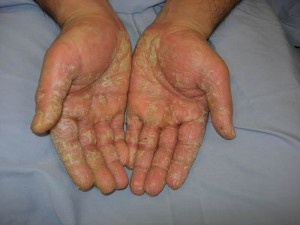 Contact dermatitis is an itchy skin rash caused by skin contact with allergens or irritants. The inflamed skin can be red, dry, cracked, and may develop tiny blisters, drain fluid, and crust over. The rash usually occurs at the sites of direct contact with culprit substance.
Contact dermatitis is an itchy skin rash caused by skin contact with allergens or irritants. The inflamed skin can be red, dry, cracked, and may develop tiny blisters, drain fluid, and crust over. The rash usually occurs at the sites of direct contact with culprit substance.
Two types of contact dermatitis are frequently seen: irritant contact dermatitis (ICD) and allergic contact dermatitis (ACD). ICD is by far the most common type. Many things can damage the out skin layer and cause skin irritation – harsh soaps, chemical solvents, cosmetics or skin products, etc. it tends to give more of a stinging sensation than itchiness. Reaction can be almost immediate with irritant contact. ACD, on the other hand, appears more vesicular and is itchier. Usually there is a lag between contact and symptom on set, as it takes time for “allergy” to develop. Common allergens include metals such as nickel, topical antibiotics, perfume and cosmetics, hair dyes, preservatives, etc. A large population is allergic to a compound called urushiol in poison ivy and oak. Clinically there are lots of overlaps between ICD and ACD.
So, pertinent history is very important for diagnosis. If ACD is suspected, patch test is helpful to look for relevant offender(s). You will be instructed about how to avoid the allergens after the patch test result is read.
Identifying and avoiding the causative agents are the most important steps in managing contact dermatitis, although sometimes is can be difficult. The mainstay treatment is topical steroids of different strengths depending on the rash location and severity. In severe cases, oral steroid with taper may be needed. Wet compresses, soothing lotions, soft soap and clothes, and antihistamine to control itchiness can also be effective adjunct therapies.